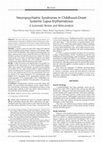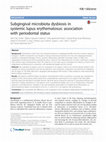Papers by Débora Calderaro

Microorganisms, Dec 28, 2023
This study evaluated the changes in the composition of oral-gut microbiota in patients with rheum... more This study evaluated the changes in the composition of oral-gut microbiota in patients with rheumatoid arthritis (RA) caused by methotrexate (MTX) and non-surgical periodontal treatment (NSPT). Assessments were performed at baseline (T0), 6 months after MTX treatment (T1), and 45 days after NSPT (T2). The composition of the oral and gut microbiota was assessed by amplifying the V4 region of the 16S gene from subgingival plaques and stools. The results of the analysis of continuous variables were presented descriptively and non-parametric tests and Spearman's correlation were adopted. A total of 37 patients (27 with periodontitis) were evaluated at T0; 32 patients (24 with periodontitis) at T1; and 28 patients (17 with periodontitis) at T2. MTX tended to reduce the alpha diversity of the oral-gut microbiota, while NSPT appeared to increase the number of different species of oral microbiota. MTX and NSPT influenced beta diversity in the oral microbiota. The relative abundance of oral microbiota was directly influenced by periodontal status. MTX did not affect the periodontal condition but modified the correlations that varied from weak to moderate (p < 0.05) between clinical parameters and the microbiota. MTX and NSPT directly affected the composition and richness of the oral-gut microbiota. However, MTX did not influence periodontal parameters.
Heart disease ( ) Kidney disease ( ) Dyslipidemia ( ) Overweight/Obesity ( ) Lung disease ( ) Thy... more Heart disease ( ) Kidney disease ( ) Dyslipidemia ( ) Overweight/Obesity ( ) Lung disease ( ) Thyroidopathy ( ) Depression ( ) Anxiety ( ) Obsessive-Compulsive Disorder ( ) Panic syndrome ( ) None ( ) Other: ___________________________ 12. Do you take any medications daily? Yes ( ) No ( ) Which: _________________ 13. Do you have a previous academic degree? Yes ( ) No ( ) Which: _________________ 14. The college where you study is: Private ( ) Public ( )
Antes de quaisquer outras pessoas que contribuíram de várias formas para a realização deste traba... more Antes de quaisquer outras pessoas que contribuíram de várias formas para a realização deste trabalho, devo eterna gratidão a todos os pacientes que dele participaram e, portanto, são os principais responsáveis por sua existência. Meu muitíssimo obrigada também à Dr a . Luciana Dias Moretzsohn, minha orientadora, e ao Dr. Marco Antônio Parreiras de Carvalho, meu coorientador, por acreditarem, apoiarem e concordarem em participar deste estudo. Agradeço a todos os funcionários e aos médicos residentes e preceptores dos Serviços

Jcr-journal of Clinical Rheumatology, Apr 23, 2019
The aim of this study was to access the prevalence of 19 neuropsychiatric syndromes in childhood-... more The aim of this study was to access the prevalence of 19 neuropsychiatric syndromes in childhood-onset systemic lupus erythematosus (cSLE), as defined by the American College of Rheumatology (ACR) in 1999, by performing a systematic review and meta-analysis of relevant publications. Methods: A literature search from April 1999 to March 2018 identified studies investigating neuropsychiatric syndromes in cSLE patients, applying 1999 ACR Case Definitions, with a sample of at least 20 patients. Case reports, small case series, reviews, articles that did not use 1999 ACR case definitions, and those with adult SLE patients were excluded. The methodological quality of the studies was determined through the Loney quality assessment. Prevalence estimates with a 95% confidence interval were combined using random-effect (DerSimonian-Laird) models. Results: A total of 143 articles were identified and 9 were included. In a population of 1463 cSLE patients, 351 (29.9%) presented 869 neuropsychiatric cSLE events (2.48 events/patient). The results for each syndrome were headache (52.2%), seizure disorders (48.6%), cognitive dysfunction (32.9%), mood disorder (28.3%), psychosis (22.7%), cerebrovascular disease (19.5%), acute confusional state (15.7%), movement disorder (9.4%), anxiety disorder (7.2%), aseptic meningitis (5.1%), mononeuropathy single/ multiplex (4.9%), myelopathy (4.2%), demyelinating syndrome (3.2%), cranial neuropathy (2.7%), polyneuropathy (2.6%), Guillain-Barré syndrome (2.5%), autonomic disorder (1.9%), plexopathy (1.3%), and myasthenia gravis (1.3%). Conclusions: Neuropsychiatric syndromes are prevalent among cSLE patients. The most prevalent were headaches, seizures, cognitive dysfunction, mood disorders, and psychosis. Determining the prevalence of each neuropsychiatric syndrome in cSLE may improve clinical awareness of these potentially fatal and disabling conditions.

Diseases of The Esophagus, Nov 1, 2009
Systemic sclerosis (SSc) is a multisystem disease of unknown etiology. Esophageal involvement aff... more Systemic sclerosis (SSc) is a multisystem disease of unknown etiology. Esophageal involvement affects 50-90% of patients and is characterized by abnormal motility and hypotonic lower esophageal sphincter. Data on the association of esophageal abnormalities and age, gender, SSc subset or duration, autoantibody profile, esophageal symptoms, and medication are lacking or conflicting. The aim of this study was the evaluation of these associations in Brazilian sclerodermic patients from the Rheumatology Division, Clinics Hospital, Federal University, Minas Gerais. They underwent medical records review, clinical interview, and esophageal manometry. The normal cutoff level for lower esophageal sphincter pressure was 14 mmHg. Abnormal peristalsis occurred when less than 80% of peristaltic waves were propagated. P-values less than 0.05 were considered significant. Twenty-eight patients were included: 71% were women. The population presented medium age and disease duration of 46 years and 12 years, respectively. Cutaneous diffuse SSc occurred in 39% and its limited form in 61%. Dysphagia, pyrosis, and regurgitation occurred, respectively, in 71%, 43%, and 61% of patients. Lower esophageal sphincter pressure and number of peristaltic waves-propagated medias were, respectively, 17.2 mmHg and 2.3. SSc-related manometric abnormalities were present in 86% of patients. Manometry revealed distal esophageal body hypomotility, hypotonic lower esophageal sphincter, or both, respectively, in 82%, 39%, and 36% of patients. One patient presented the manometric pattern of esophageal achalasia. Male patients more frequently presented hypotonic inferior esophageal sphincter. Manometric findings have had no relationship with the other variables. Nifedipine use did not influence manometric findings.
PEC Innovation, Dec 1, 2023
Janus kinase inhibitors (JAKi) are indicated as second-line therapy for rheumatoid arthritis (RA)... more Janus kinase inhibitors (JAKi) are indicated as second-line therapy for rheumatoid arthritis (RA), after synthetic or biologic failure, with proven efficacy and safety in clinical trials. However, evaluation of JAKi in local RA populations is necessary, through real life studies.
Rev. méd. Minas Gerais, 2006
Community-acquired Pseudomonas aeruginosa pneumonia in previously healthy adults is uncommon. The... more Community-acquired Pseudomonas aeruginosa pneumonia in previously healthy adults is uncommon. The clinical presentation is nonspecific. We report the case of a patient that survived after correct diagnosis and prolonged therapeutics with appropriate antibiotics, whose clinical presentation and findings on chest roentgenogram and computed tomography had led us to the initial diagnostic consideration of pulmonary tuberculosis.
Acta Fisiátrica, Jun 30, 2021
Objective: This study aims to describe the development and online distribution of a patient educa... more Objective: This study aims to describe the development and online distribution of a patient education booklet about systemic scleroderma focused on occupational therapy orientations. Methods: The research-action methodology was applied and divided into the following five steps: analysis of patients' requests, preparation of the content, choice of illustrations and graphic design, developers' approval of the education booklet, and online distribution. Results: The education booklet entitled "Occupational Therapy Guidelines for People with Systemic Sclerosis" was developed, and its online distribution reached nearly 5000 people. Conclusion: Educational materials serve as adjuncts to the treatment of chronic diseases, as systemic scleroderma. The online distribution of these materials expands its reach among these patients.
Annals of the Rheumatic Diseases, Jun 1, 2015
The MetS, which is a constellation of vascular risk factors, was significantly associated with co... more The MetS, which is a constellation of vascular risk factors, was significantly associated with coronary and peripheral arterial events in patients with SLE. Moreover, the presence of the MetS within 5 years of latest follow-up was associated with mortality and the occurrence of ESRF.

PubMed, Nov 18, 2015
Objectives: The aim of this study was to evaluate the efficacy of atorvastatin to reduce the plas... more Objectives: The aim of this study was to evaluate the efficacy of atorvastatin to reduce the plasma levels of TNF system molecules (TNF-α, sTNFR1 and sTNFR2) and to assess their association with risk factors for accelerate atherosclerosis and clinical disease activity scores in SLE patients. Methods: In a previous study, 64 female SLE patients received 20 mg/day of atorvastatin and 24 SLE patients (non-treated group) were followed for 8 weeks. Plasma levels of TNF-α, sTNFR 1 and sTNFR 2 were measured by ELISA, at baseline and at the end of the study. Results: The plasma levels of sTNFR1 and sTNFR 2 showed a positive correlation with SLEDAI score. We also found a positive correlation between TNF-α and sTNFR 1 levels and SLICC score. Patients with current nephritis and patients with anti-ds-DNA antibodies presented higher sTNFR1 and sTNFR2 levels. Patients with abdominal obesity and arterial hypertension also had higher plasma levels of soluble receptors. At the end of 8 weeks, we observed a significant decrease in sTNFR1 plasma levels in patients receiving atorvastatin [median (percentile), 876.5 (717-1284 pg/ml) vs. 748 (629.6-917.3 pg/ml), p=0.03], without difference regarding TNF-α and sTNFR2 plasma levels. The SLEDAI and SLICC scores were independent determinants of the plasma levels of sRTNF1. Conclusions: Atorvastatin reduced soluble receptors of TNF-α. The plasma levels of TNF-α, sTNFR1 and sTNFR2 may play a role in SLE activity and atherosclerosis, and might be evaluated as targets for new therapies.

Microbiome, Mar 20, 2017
Background: Periodontitis results from the interaction between a subgingival biofilm and host imm... more Background: Periodontitis results from the interaction between a subgingival biofilm and host immune response. Changes in biofilm composition are thought to disrupt homeostasis between the host and subgingival bacteria resulting in periodontal damage. Chronic systemic inflammatory disorders have been shown to affect the subgingival microbiota and clinical periodontal status. However, this relationship has not been examined in subjects with systemic lupus erythematosus (SLE). The objective of our study was to investigate the influence of SLE on the subgingival microbiota and its connection with periodontal disease and SLE activity. Methods: We evaluated 52 patients with SLE compared to 52 subjects without SLE (control group). Subjects were classified as without periodontitis and with periodontitis. Oral microbiota composition was assessed by amplifying the V4 region of 16S rRNA gene from subgingival dental plaque DNA extracts. These amplicons were examined by Illumina MiSeq sequencing. Results: SLE patients exhibited higher prevalence of periodontitis which occurred at a younger age compared to subjects of the control group. More severe forms of periodontitis were found in SLE subjects that had higher bacterial loads and decreased microbial diversity. Bacterial species frequently detected in periodontal disease were observed in higher proportions in SLE patients, even in periodontal healthy sites such as Fretibacterium, Prevotella nigrescens, and Selenomonas. Changes in the oral microbiota were linked to increased local inflammation, as demonstrated by higher concentrations of IL-6, IL-17, and IL-33 in SLE patients with periodontitis. Conclusions: SLE is associated with differences in the composition of the microbiota, independently of periodontal status.

Revista de Terapia Ocupacional da Universidade de São Paulo, May 18, 2020
Objetivo: Grupos de orientação para pacientes com artrite reumatoide (AR) têm boa aceitação, mas ... more Objetivo: Grupos de orientação para pacientes com artrite reumatoide (AR) têm boa aceitação, mas benefícios controversos no tratamento dessa doença. Este estudo visa a avaliar seu impacto sobre a qualidade de vida e a dor em pacientes com AR. Métodos: Ensaio clínico piloto de intervenção em grupos de orientação que incluiu 15 pacientes com AR. Foram realizados 12 encontros de duas horas por semanas, que abordaram ações educativas sobre a doença, o tratamento, medidas de proteção articular e conservação de energia, atividades terapêuticas ocupacionais e oficinas de vivências. Foram utilizados a escala visual analógica de dor (EVA dor) e o sistema descritivo em três níveis de cinco dimensões do EuroQol e sua escala visual analógica (EQ-5D-3L e EQ-VAS) para avaliação da qualidade de vida. Resultados: Catorze (93%) pacientes eram do gênero feminino, com idade média 61,27 anos, tempo médio de doença de 19,93 anos. Treze (87%) deles apresentavam deformidades articulares em mãos pela AR. Houve melhora significativa no domínio cuidados pessoais do EQ-5D-3L (p=0,046) e tendência à redução da dor (EVA dor) e melhora da qualidade de vida (EQ-5D-3L e EQVAS), sem significância estatística (P>0,05). Conclusões: Apesar do pequeno número de pacientes incluídos neste estudo piloto, a melhora dos cuidados pessoais, da autopercepção da dor e da qualidade de vida dos pacientes sugere que houve impacto positivo da educação, das atividades terapêuticas ocupacionais e do compartilhamento de vivências entre os pacientes com AR.

Ao orientador, Prof. Antônio Lúcio Teixeira Júnior, pela dedicação, compreensão e ensinamentos. À... more Ao orientador, Prof. Antônio Lúcio Teixeira Júnior, pela dedicação, compreensão e ensinamentos. À co-orientadora, Profa. Gilda Aparecida Ferreira, pela dedicação, compreensão, ensinamentos e apoio. À Profa. Tarcília Aparecida da Silva, pela participação na linha de pesquisa e pelo acolhimento dos pacientes que necessitavam tratamento odontológico. Às minhas companheiras odontólogas, Jôice Dias Corrêa e Santuza Maria Souza de Mendonça, que se dedicaram integralmente a este trabalho e sem as quais o mesmo não existiria. Aos acadêmicos Fabrícia Xavier Santos e João Guilherme Capinam Sanção, pela responsabilidade, participação e cooperação. Aos pacientes com lúpus eritematoso sistêmico e voluntários que concordaram em participar deste estudo. A todos os integrantes do Serviço de Reumatologia do Hospital das Clínicas da Universidade Federal de Minas Gerais, pela compreensão e cooperação. Um agradecimento especial à Neusa Beata, secretária do Serviço, pela ajuda incomensurável. Ao Dr. Fabiano Brito, pela intermediação e apoio na realização de exames complementares. À Liliane Souza Passos de Carvalho, secretária do Departamento do Aparelho, pelo apoio. Aos meus amores incondicionais, o grande, meu marido Micael, e o pequeno, meu filho Rodrigo, pela grande alegria que trazem à minha vida, pelo apoio e, sobretudo, pela compreensão nos longos momentos de ausência. Àquele que considero um filho emprestado, Micael Filho, pelo carinho, pela presença, pela compreensão e pelo apoio. Aos meus pais. Francisco e Elza, e irmãos, Raquel e Daniel, cujo carinho, apoio e substituição nas ausências diárias foram essenciais. Aos meus amigos de vida inteira, infância, adolescência, faculdade e mais recentes, próximos ou distantes, que sempre estão por aqui nos momentos mais importantes. correlated to SLICC/ACR. On multivariate analysis, only age was independently associated to periodontitis in SLE patients. Conclusions: Periodontitis frequency and severity were similar in SLE patients and in subjects of the control group. SLE patients with periodontitis were younger than control group participants with periodontitis. Periodontal parameters were associated with variables associated with SLE duration, cumulative corticosteroid dosage and SLICC/ACR, suggesting that periodontitis may increase the risk of damage in SLE.
Rev. méd. Minas Gerais, 2011
... Mariana Motta Baeta Salvador Chalup Avenida Professor Alfredo Balena, 190 Belo Horizonte, MG ... more ... Mariana Motta Baeta Salvador Chalup Avenida Professor Alfredo Balena, 190 Belo Horizonte, MG Brasil CEP: 30130100 Email: marisalvadorchalup@yahoo.com.br RESUMO Pacientes com tireotoxicose podem cursar com alterações psiquiátricas como depres-são, mania ...
JMIR Research Protocols, Apr 9, 2021
Heart disease ( ) Kidney disease ( ) Dyslipidemia ( ) Overweight/Obesity ( ) Lung disease ( ) Thy... more Heart disease ( ) Kidney disease ( ) Dyslipidemia ( ) Overweight/Obesity ( ) Lung disease ( ) Thyroidopathy ( ) Depression ( ) Anxiety ( ) Obsessive-Compulsive Disorder ( ) Panic syndrome ( ) None ( ) Other: ___________________________ 12. Do you take any medications daily? Yes ( ) No ( ) Which: _________________ 13. Do you have a previous academic degree? Yes ( ) No ( ) Which: _________________ 14. The college where you study is: Private ( ) Public ( )

Clinica Chimica Acta, Dec 1, 2019
Background: Systemic Lupus Erythematosus (SLE) is an autoimmune, multisystemic disease. Currently... more Background: Systemic Lupus Erythematosus (SLE) is an autoimmune, multisystemic disease. Currently diagnosis depends on complex criteria developed by the American College of Rheumatology. Moreover, the lack of specific biomarkers also challenges the diagnosis. Methods: Inflammatory biomarkers such as IL-8, IP-10, MIG, MIP-1α and RANTES were measured in serum samples from SLE patients and subjects in control groups (patients with other autoimmune diseases and healthy individuals). Forty-six SLE patients (22 patients with low activity, SLEDAI-2 K ≤ 4, 24 patients with moderate/ high activity, SLEDAI-2 K > 4), 42 patients with other autoimmune diseases (OAD group), and 8 healthy volunteers participated in this study. Results: MIG (p < .001) and RANTES (p < .001) concentrations in SLE patients and healthy controls, and IP-10 concentrations in SLE patients with different disease activities (low activity, p < .01, moderate/high activity, p < .05) differed significantly. IL-8 (p < .001) and MIP-1α (p < .001) concentrations in SLE patients differed from those in patients from the OAD group. IL-8 (p < .05), IP-10 (p < .01), MIG (p < .05), MIP-1α (p < .001), and RANTES (p < .05) were correlated with SLE activity; their concentrations in SLE patients with low and moderate/high activity differed significantly. Conclusions: Given the findings of this study, one can envision the possibility of future use of some of these cytokines to assist in the screening of SLE patients, or even in monitoring disease activity.
XXXIX Congresso Brasileiro de Reumatologia, Sep 12, 2022
JAK inhibitors (JAKi) and biologic disease-modifying anti-rheumatic drugs (bDMARDs) are indicated... more JAK inhibitors (JAKi) and biologic disease-modifying anti-rheumatic drugs (bDMARDs) are indicated as second-line therapy for rheumatoid arthritis (RA), after synthetic or biologic failure, with proven efficacy and safety in clinical trials. However, evaluation of JAKi and bDMARDs efficacy and safety in real-world RA populations is necessary.
Journal of Critical Care, Aug 1, 2023









Uploads
Papers by Débora Calderaro